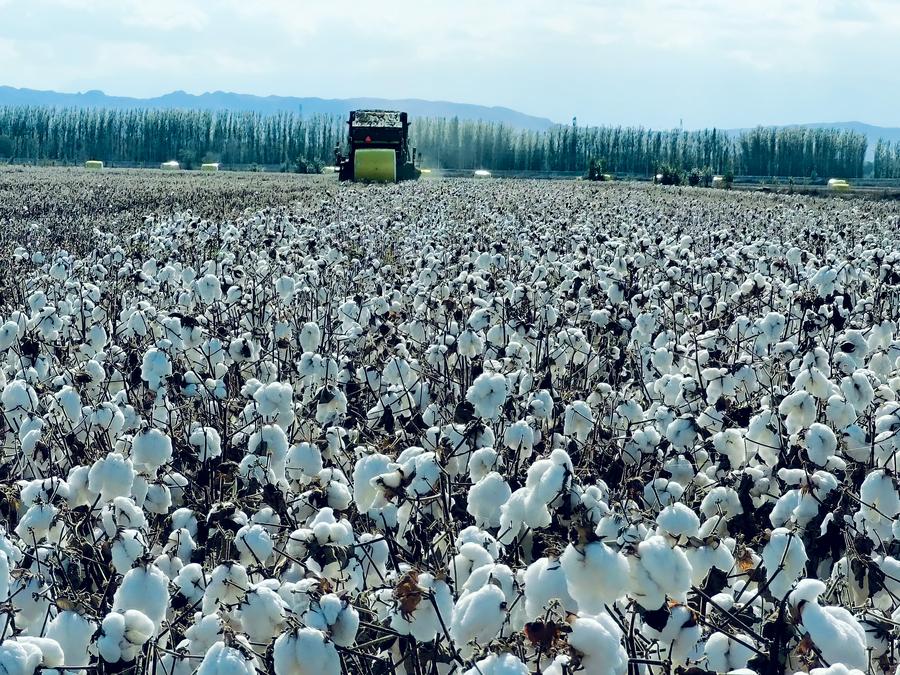
URUMQI - Northwest China's Xinjiang has entered a new season of cotton cultivation, with many farmers confident they will secure a stable income from their cotton fields despite Western sanctions built upon "forced labor" claims.
Southern Xinjiang, which has a warm climate, began planting cotton in late March, while in the north, seed sowing is expected to be in full swing by mid-to-late April.
Large machines moving across vast cotton fields are currently a common sight in the autonomous region, which leads the country in mechanized cotton farming with a mechanization rate of 100 percent for cotton planting and about 90 percent for harvesting.
READ MORE: Xinjiang backs firms' growth, counters US sanctions
As one of the world's leading cotton-producing areas, Xinjiang reported a cotton output of 5.69 million tonnes in 2024, accounting for over one-fifth of the world's total. According to the regional government, cotton farming is a primary source of income for about 327,000 local households, over 70 percent of which are of ethnic minority groups.
This year, Xinjiang's cotton-growing area is projected to remain the same or edge up from the 36.7 million mu (2.45 million hectares) recorded in 2024, according to government and industry association sources, suggesting an unwavering commitment to cotton planting among local farmers.
Yasin Imin, a cotton farmer in Xayar, one of southern Xinjiang's key cotton-producing counties, said that despite the disruptive impact of Western sanctions, Uygur farmers like him continue to plant cotton as it generates more income than grain cultivation. For example, 1 mu of wheat yields a net income of 600 yuan (about $83.33), while cotton yields about 1,300 yuan, he said.
READ MORE: China refutes smears against Xinjiang on so-called ‘forced labor’
Situated on the edge of the Taklimakan Desert, the largest desert in China, Xayar benefits from abundant sunlight and heat, along with a long frost-free season, making it an ideal place to grow cotton.
The county's cotton farming has a history of more than 1,000 years. Thanks to rapid mechanization and cooperative management, the work is no longer labor-intensive but getting smarter and seeing higher productivity.
Eziz Ahmat, another Xayar local, and his wife used to sow their 1.3-hectare cotton field with a small tractor until about a decade ago. He now works with a local cooperative and oversees spring sowing on a farm 100 times larger, aided by high-powered planting machines.
"Modern machinery has made what used to be back-breaking labor so much easier," the 42-year-old said, adding that his cooperative job brings in an extra salary, which, along with the earnings from his leased land, has increased his annual income fourfold.
ALSO READ: Drilling completed in Xinjiang on Asia's deepest vertical well
The jobs offered by the cooperative -- from cotton field management to machinery operations -- are highly sought-after. "There are even people traveling from miles away to vie for a job here, attracted by the high incomes," he said.
Xinjiang has developed a long industrial chain centered around cotton, extending from fertilizer production and agricultural machinery to spinning and garment production, and employing more than 1 million people.
However, sanctions imposed over "forced labor" allegations have put this pillar industry under pressure. Since 2018, many enterprises in Xinjiang have been added to sanction lists by the United States and some other Western countries. As export orders plummeted, many businesses had to scale back production and lay off workers.
Local farmers and firms interviewed by Xinhua have decried these sanctions as groundless and ill-intended -- imposed to suppress the main competitor of US cotton. They argue that Xinjiang's cotton has been competitive worldwide thanks to the region's combined advantages in productivity and cotton quality.
ALSO READ: Foreign envoys laud progress of Xinjiang
To cushion the impact of the sanctions, Xinjiang's local government and enterprises have been exploring new markets for their cotton products while doubling down on agricultural technology, promoting advanced machinery and accelerating the development of high-standard farmland -- all to preserve the region's competitiveness in the industry.
Its resilience despite these challenges is remarkable, with over 90 percent of the cotton varieties cultivated in the region now bred independently, according to Su Xuhong, secretary-general of the regional cotton association.
"Xinjiang has risen against the odds to become the largest cottonseed production base in China, with processing reaching internationally advanced levels," she said.


